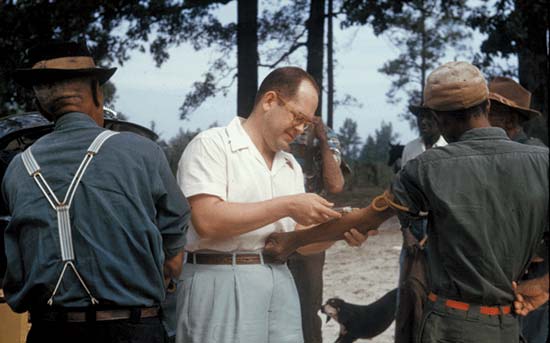Thousands of protesters line the streets of cities around the United States, demanding equality and the end of police brutality for African-Americans. When we think of the Black Lives Matter movement, many of us may think that the death of an African-American man named George Floyd sparked these protests, but the history of systemic racism goes back much further. In particular, healthcare throughout history is far from being innocent of racism, from experimenting on black women to refusing healthcare for black patients. As healthcare providers, it is our responsibility to provide treatment for people, no matter their race, abilities, sexual orientation, religion, and more.

John Marion Sims conducted experimental surgeries on enslaved women
In 1845, John Marion Sims, an Alabamian surgeon, began doing experimental surgeries for vesicovaginal fistulas, which are abnormal connections between the bladder and vagina caused by prolonged childbirth that result in incontinence.
He is widely regarded as the Father of Modern Gynecology for his contributions in developing life-changing surgeries and instruments, but many criticize his exploitation of black women in the process of finding these solutions. To illustrate, these surgeries were done on enslaved women without anesthesia, and while anesthesia was a new invention in the medical field at the time as the first publicly demonstrated surgery using anesthesia was only done a year later in 1846, these women were repeatedly operated on for his experimental surgeries.
In fact, a 17 year old woman known as Anarcha was operated on 30 times to test Sims’s experimental surgery, without ever using anesthesia. Another woman named Lucy was described to have been screaming and crying out in pain during the surgeries, and as Sims later wrote, “Lucy’s agony was extreme”. Many doctors at the time, including John Marion Sims, believed that black patients didn’t feel pain like white patients. This is called racial bias, and even today, racial bias is prevalent when assessing for pain in black versus white patients. For example, only 57% of black patients received pain medication for fractures in the emergency room, compared to 74% of white patients, despite similar descriptions of their pain.
In John Marion Sims’s experiments, there is no historical record of him ever collecting consent from the women he performed his experimental surgeries on, and while their participation has greatly contributed to our understanding of the female anatomy, it doesn’t justify the fact that he subjected many black women to extreme pain and risked their lives multiple times. While some may say that his surgeries aren’t an example of racism as he intended to help treat their pain, he was allowed to test on enslaved black women when it never would’ve been socially acceptable to operate on a white woman 30 times for an experimental surgery, which shows how racism has impacted healthcare throughout history.
The Tuskegee Syphillus Study

Racism in healthcare goes beyond Sims’s experiments. In 1932, 600 black men, 399 with latent syphillus and 201 without the disease, were enrolled in a project originally known as “The Tuskegee Study of Untreated Syphillus in the Negro Male”. They were told that they would be compensated with free healthcare and other benefits, but as the title of the study suggested, the men were not treated for their syphillus, and the researchers watched as they exhibited severe symptoms and gradually died of the disease.
40 years later, this study was brought to attention, and it was discovered that the men were not told the purpose of the study, the name of the study, or the potential consequences it may have for their health and safety. The researchers took advantage of the mostly poor and illiterate sharecroppers, and actively refusing to treat them, even after penicillin was discovered as a treatment, to study the effects of the disease when the men had no idea what was actually happening to them.
By 1972, 28 participants had died of the disease and 100 more had died from other complications associated with syphillus. This led to many African-Americans distrusting public health officials, and even today, black patients generally report poorer ratings of interpersonal healthcare, often times due to the physician’s implicit bias. African-Americans have been exploited in many scientific studies throughout history, with the Tuskegee Syphillus Study being a prominent example of researchers doing unethical tests on unknowing participants.
“The United States government did something that was wrong—deeply, profoundly, morally wrong. It was an outrage to our commitment to integrity and equality for all our citizens… clearly racist.”
President Bill Clinton’s apology for the Tuskegee Syphillus Study to the remaining eight survivors in 1997
In 1951, cells were taken from Henrietta Lacks without her consent

Many of these black patients also unknowingly contributed to important medical advancements that would save millions of lives, but were not fairly compensated. For example, in 1951, a poor black woman named Henrietta Lacks was admitted to Johns Hopkins Hospital for cervical cancer. During that time, very few hospitals would treat black patients, but Johns Hopkins Hospital did even though it segregated black and white patients.
While doing her examination, Dr. Howard Jones found a large tumor on her cervix, and sent the biopsy samples to Dr. George Gey, who was a cancer researcher. For years, scientists had been trying to grow human cells that could replicate indefinitely, but had failed because most cells die after 40 to 60 divisions. However, the tumor cells taken from Henrietta Lacks, called HeLa cells, could grow indefinitely in-culture, something that had never happened before, making it the first immortal human cell line.
Samples of HeLa cells were sent all over the world, and scientists profited billions of dollars from these cells. At the time, doctors did not regularly collect informed consent from the patients, and this turned out to be an issue. Henrietta’s family never knew that her cells had been harvested and were being grown in laboratories around the world, so in the 1970s, the Lacks family received a phone call asking for their blood samples because many other cell cultures had been contaminated with HeLa cells and scientists needed to figure out which ones were HeLa cells by testing its DNA.
This was the first time they had ever heard of the HeLa cells because the doctors had taken Henrietta’s cells without her consent, so while scientists profit off of the cells, the Lacks family hadn’t received any compensation. While Dr. George Gey and the researchers at Johns Hopkins Hospital never intended to harm Henrietta’s family out of racism or for any other reason, this began a long battle for fair financial compensation and rights to the HeLa cells for the Lacks family.
However, even though she never knew it, Henrietta Lacks helped develop the polio vaccine, cancer treatments, in-vitro fertilization, cloning, and other important discoveries in biomedical research, which helped save million of lives with her immortal cells.
Racism in healthcare has been a significant issue in history, as black patients were commonly exploited. Yet today, it remains an important issue as many studies have shown the effects of racial bias that negatively influences the treatment received by black patients. African-American doctors and patients throughout history have made important discoveries in the field of science and biomedical research, and we need to acknowledge all the things they endured that contributed to our understanding of healthcare. Therefore, we need to create change for a better future for the millions of patients impacted by the unfair healthcare system.
Bibliography
Vernon, Leonard F. “J. Marion Sims, MD: Why He and His Accomplishments Need to Continue to Be Recognized a Commentary and Historical Review.” Journal of the National Medical Association, Elsevier, 7 Mar. 2019, www.sciencedirect.com/science/article/pii/S0027968418302839.
Holland, Brynn. “The ‘Father of Modern Gynecology’ Performed Shocking Experiments on Slaves.” History.com, A&E Television Networks, 29 Aug. 2017, www.history.com/news/the-father-of-modern-gynecology-performed-shocking-experiments-on-slaves.
Hoffman, Kelly M., et al. “Racial Bias in Pain Assessment and Treatment Recommendations, and False Beliefs about Biological Differences between Blacks and Whites.” PNAS, National Academy of Sciences, 19 Apr. 2016, www.pnas.org/content/113/16/4296.full.
Dixon, Camryn. “The American Health Care System Has a Long History of Racism.” Teen Vogue, www.teenvogue.com/story/the-roots-of-racism-in-healthcare.
“About the USPHS Syphilis Study.” Tuskegee University, www.tuskegee.edu/about-us/centers-of-excellence/bioethics-center/about-the-usphs-syphilis-study.
Butanis, Benjamin. The Legacy of Henrietta Lacks, 9 Mar. 2020, www.hopkinsmedicine.org/henriettalacks/.
Zielinski, Sarah. “Henrietta Lacks’ ‘Immortal’ Cells.” Smithsonian.com, Smithsonian Institution, 22 Jan. 2010, www.smithsonianmag.com/science-nature/henrietta-lacks-immortal-cells-6421299/.
Cooper, Lisa A et al. “The associations of clinicians’ implicit attitudes about race with medical visit communication and patient ratings of interpersonal care.” American journal of public health vol. 102,5 (2012): 979-87. doi:10.2105/AJPH.2011.300558



